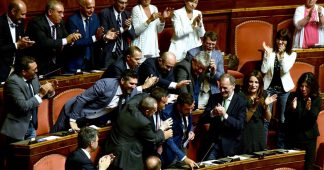Why would the bodily incarnation of neoliberalism represent a solution to Italy’s woes?
Photo Illustration: 731; Tim Wegner/laif/Redux
Today’s vote of confidence in the lower house of Parliament, the Chamber of Deputies, which follows yesterday’s vote in the Senate, will officially mark the beginning of Italy’s new government, led by former ECB president Mario Draghi. It’s little more than a formality at this point, given his cross-party support.
This comes on the heels of Matteo Renzi’s decision to pull the plug on the Conte II government, comprising chiefly the Five Star Movement (M5S) and the Democratic Party (PD. There’s been much speculation about Renzi’s move. Is this the unintended consequence of a failed gamble on his part, possibly aimed at gaining more leverage within a “renewed” Conte administration? Or was this his intended outcome all along? I think the latter scenario is the more likely one; Renzi is a lot of things, but stupid he ain’t. According to several sources, in fact, Draghi was directly involved in the machinations that led Conte to step aside, with Renzi eventually moving away only once he had obtained reassurance from Draghi (and, one must assume, president Mattarella himself) that the former central banker was ready to step in.
An even bigger question, then, is why Draghi is now willing to risk dragging his now-immaculate, larger-than-life reputation through the blood, sweat, and tears of day-to-day politics, when he could have waited another year to easily scoop up the seat of new president of the Republic? This position is an “institutional”, purportedly “non-partisan” role much more befitting for someone with Draghi’s CV and one that he is currently the favourite candidate for (given the current composition of Parliament). Is it, as left-leaning and Conte-supporting commentators argue, because Conte government’s timid social-interventionist measures – a temporary ban on layoffs, the part-renationalisation of highways operator Autostrade per l’Italia and bailing out of national carrier Alitalia – incurred the wrath the country’s business and financial elites?
Or perhaps it is just a gambit by Renzi gone terribly wrong, and Draghi has been called in as the only person who had any hope of cobbling together a majority. After all, a Draghi government would mean no snap elections, which would almost certainly yield a victory for the Salvini-led centre-right coalition – a prospect the establishment wants to avoid at all costs.
What I actually think more likely is that Giuseppe Conte was not considered strong enough to manage the “great reset” of Italy’s economy – which entails for example letting ailing firms die to allow the market to unleash its “creative destruction”, as Draghi hinted in his address to Parliament – that domestic and international elites consider necessary for the country, an endeavour that can only be pulled off by a “technical” – or technocrat-led – government.
Time will answer these questions. More interesting is what the prospect of a Draghi government tells us about the nature of Italian (post-)democracy, and the perverse effects that the euro has had on the country’s economic, social and political fabric. Draghi’s descent into politics has been accompanied by feverish cries of jubilation by the mass media – on a level that would have probably caused embarrassment even to North Korean state media. And virtually all parties in Parliament – including Salvini’s Northern League, which seems to have jettisoned what little was left of its “eurosceptic” posturing – have expressed their support. The tone of the discussion was captured well by the powerful governor of the Campania region, Vincenzo De Luca (PD), who compared Draghi to none other than “Christ”.
Virtually everyone seems to agree: a Draghi government would be a blessing for the country, a final opportunity to redeem its sins and “make Italy great again”. Such prophecies aren’t based on an analysis of what Draghi’s policies may actually be – and whether they would be in the interest of the country and its citizens, workers and businesses – but on vague references to the man’s “charisma”, “competence”, “intelligence” and “international clout”. This is a reflection of a sick political culture, whereby statecraft is reduced to a purely technical affair, in which notions such as power, class, ideology are erased from the equation. Instead, they are seen as inconvenient hindrances to the “efficient” management of government, which only requires the “expertise” of well-studied (and politically neutral almost by definition) “technicians” or technocrats.
This concept is well summed up by the notion of “technical government”, which most non-Italians readers are likely to be baffled by. Indeed, to my knowledge the concept doesn’t exist in practically any other Western country. The basic idea is that in moments of deep crisis only “experts” supposedly untainted by political partisanship and unburdened by the complications of parliamentary politics can be trusted with making the “right” and “necessary” decisions, painful and costly as they may be.
It’s a concept that, alas, has a long-running history in Italy, and which harks back to the fraught relationship that the country’s economic elites have always had with mass social democracy, and how they sought to resolve this tension by resorting to self-imposed “external constraints” of various nature. Throughout the 1970s and 1980s, Italy’s ruling elites were faced with an increasingly militant and “ungovernable” working class and a state-centric, redistributive political economy (grounded in the country’s socialist-leaning Constitution) that was deeply incompatible with the emerging neoliberal paradigm. They thus began to theorise that only by “tying the hands” of government via a political-economic straitjacket – an external constraint or vincolo esterno – could they hope to achieve a dual objective. Their aim was to essentially “break the back” of the working classes while spearheading those “reforms” for which there was very little popular consensus. And that vincolo esterno was, of course, the process of European integration, beginning with the system of semi-fixed exchange rates known as European Monetary System (EMS), in 1979, all the way up to Maastricht and then the euro (EMU).
One of the main advocates of the vincolo esterno was Guido Carli, Italy’s highly influential economic minister from 1989 to 1992, not to mention one of the mentors of Mario Draghi. In his memoirs Carli made no secret of the fact that “the European Union represented an alternative path for the solution of problems which we were not managing to handle through the normal channels of government and parliament”. Namely, the wholesale transformation, or neoliberalisation, of the country’s political economy. This can be said to embody what Edgar Grande calls the “paradox of weakness”, whereby national elites transfer some power to a supranational policymaker (thereby appearing weaker) in order to allow themselves to better withstand pressure from societal actors by testifying that “this is Europe’s will” (thereby becoming stronger). In this sense, Italy’s decision to join the EMS and then the EMU cannot be understood solely in terms of nationally framed interests. Rather, as James Heartfield pointed out, it should be viewed as the way in which one part of the “national community” (the economic and political elite) was able to constrain another part (labour).
The concept of “technical government” is largely a by-product of the vincolo esterno. On the one hand, the apparently inexorable logic of the external constraint – be it the maintenance of a fixed exchange rate or the need to appease “markets” or “the EU” in order to avoid retaliation – creates a semi-permanent “state of exception”. This means that at any moment the complex dynamics of parliamentary politics may need to give way to “non-political” (i.e., “technical”) governments tasked with “getting the job done”. Such a move implies that the policies they carry out are not a political choice but something entirely rational and necessary, which Parliament should limit itself to rubber-stamping without asking too many questions.
On the other hand, the economic and social effects of the external constraint – particularly disastrous in Italy’s case – create growing tensions between the demands of citizens and the requirements of the external constraint (and the inter/supranational institutions overseeing it), which national governments are unable to resolve because they lack all the “normal” instruments of economic policy necessary to maintain societal consensus. Which then leads them to turn to technocrats to resolve the impasse, by having them implement the measures the parties don’t want to take responsibility for.
It’s no coincidence that the era of the technical governments begins in the early 1990s, following Italy’s signing of the Maastricht Treaty, which was negotiated by none other than – you guessed it – Mario Draghi, at the time director general of the Italian Treasury. The first technocrat-led government, led by former governor of Italy’s central bank, Carlo Azeglio Ciampi, was formed in 1993 and inaugurated the first round of mass privatisation of state assets. Just a few years later, it was the turn of Lamberto Dini, prime minister between 1995 and 1996. Dini continued on the path of privatisation and “fiscal responsibility” inaugurated by Ciampi, for example by forcing through a major pension reform. It goes without saying that both Ciampi and Dini justified their policies largely by appealing to the external constraint of the European Monetary System (the euro wasn’t born yet) and to the fact that “this is what Europe demands from us”.
Throughout this entire period, Draghi, in his capacity as director general of the Treasury, was one of the main proponents of the privatisation of Italy’s state-owned companies, and of the vincolo esterno in general. As Featherstone and Dyson note, “[a]s a technocratic, non-party minister himself, in his soul [Draghi] believed in EMU as a vincolo esterno”, without which “the politicians could not be relied upon to accept long-term budget discipline”.
The fall of Berlusconi’s last cabinet, in 2011, saw the ushering in of another technocrat, Mario Monti, former European commissioner and an international advisor to Goldman, who proceeded to administer a devastating austerity “cure” recommended by Brussels. This was largely a consequence of the decision by the newly-appointed president of the ECB – yes, Mario Draghi again – to stop the purchases of Italian government bonds, which caused Italian interest rates to skyrocket.
In short, either in his capacity as director general of the Treasury or president of the ECB, Draghi oversaw mass privatisation, severe public spending cuts, and tax hikes that all had a deleterious impact on Italy.
Herein lies the paradox of Italy’s external constraint; namely, whenever a “technical government” is called in to enforce it, the end result is always a worsening of the country’s social and economic fabric. This makes political parties increasingly unable to solve the fundamental contradictions of the system within framework of the external constraint (i.e., the euro). In turn, this paves the way for the next technical government, in a perverse feedback loop. The experience of the Monti government is a perfect case in point: the healthcare cuts administered by Monti, as well as other administrations, and demanded by the European Commission, left the Conte administration dramatically ill-prepared to fight the COVID-19 outbreak. The architecture of the euro continued to impede an efficient response, despite extensive central bank support and the temporary suspension of the EU’s budget rules. This led to mounting economic and social costs, and ended up placing a growing strain on the government – an impasse that we are now told can only be solved by yet another deus ex machina technocrat.
This is madness. There is little doubt that Italy’s crisis must be regarded as a crisis of the post-Maastricht order of Italian capitalism, and more in general of the logic of the external constraint based upon privatisation, fiscal austerity, and wage compression. This hasn’t just entailed the permanent stagnation of Italy’s economy but has also had the effect of dis-articulating the normal functioning of democracy. If that is the case, then it is folly to think that Mario Draghi – literally the bodily incarnation of the political-economic model that has ruined Italy – can represent a solution.
Draghi didn’t just directly oversee the dismantling of Italy’s public industry and application of severe austerity in the early 1990s during his position at the Italian Treasury. He also fine-tuned the external constraint itself, by spearheading the transformation of the euro system from a dysfunctional but formally democratic monetary union into an inter/supranational governance structure where governments are disciplined and punished through a complex array of institutional mechanisms.
A system in which the formal democratic process itself is systematically subverted through financial and monetary blackmail – first and foremost at the hands of the ECB – to the point that one may reasonably question whether euro area member states can still be considered democracies. Even according to the narrow “bourgeois” understanding of the concept, one would certainly be hard-pressed to still consider Italy as such. Especially now that Mario Draghi has been called in to finish the job he began thirty years ago.
* Thomas Fazi is a writer, journalist and translator. His latest book ‘Reclaiming the State’ is published by Pluto Press.
Published at braveneweurope.com











